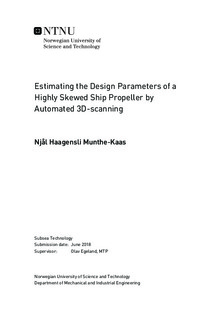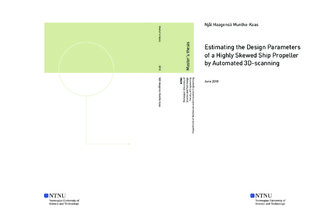| dc.description.abstract | Ship propellers have a highly complex surface geometry. Certain design parameters are commonly used to describe this complex geometry. During production of the propeller blades there is a need for measuring the blade surfaces to ensure that the blades are manufactured according to the standard tolerances. Current measurement techniques are slow and can only measure discrete points on the surface. Therefore, the propeller manufacturing industry is interested in finding measurement solutions that can measure the whole blade surface at once. 3D scanners have the potential of measuring the whole blade surface in a short amount of time. But one thing is to capture the geometry data itself, another is to be able to do something useful with this data.
This is where the design parameters of the propellers come in. If these parameters can be estimated from the data a 3D scanner captures, this could be used to measure the propeller blades during manufacturing. The blades could then be grinded down until the measured parameters are in accordance with the design data. Such a system could also be used for reverse engineering of propellers, with the goal of creating a CAD model of a propeller when no design drawing for the propeller is present.
In this report, an automatic scanning system consisting of a structured light 3D scanner, an industrial robot and a laser distance sensor is presented. A controllable pitch propeller blade is scanned using an algorithm for automatic generation of the robot scan poses. The challenges of scanning a controllable pitch propeller blade is described. Then, a method for estimating the design parameters of the propeller based on the scan is presented. The relevant theory describing how the parameters are defined is outlined.
Experimental results from the estimation of the design parameters are presented, and compared to results from a high-end optical metrology system.
The results produced by the developed system are encouraging, considering they are based on the first few tests. With some improvements the system could prove to be a much cheaper solution for in-line measurements and reverse engineering of propellers than comparable systems. The system also looks to be easy to integrate with a grinding robot, which means we could see a robot cell with completely automated grinding and finishing of propeller blades in the future. | |

